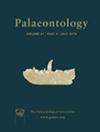Modelling height–diameter relationships in living Araucaria (Araucariaceae) trees to reconstruct ancient araucarian conifer height
IF 2.3
2区 地球科学
Q1 PALEONTOLOGY
引用次数: 0
Abstract
To reconstruct a fossil forest in three dimensions, an accurate estimation of tree height is crucial. However, modelling the height–diameter relationship of ancient trees is difficult, because the trunks of fossil trees are usually fragmentary, making direct height measurements impossible. One practical approach for reconstructing ancient tree height is to use growth models based on the height–diameter relationships of the nearest living relatives of fossil taxa. Here we apply 19 models to describe height–diameter relationships of living Araucaria trees for establishing appropriate models for ancient Araucariaceae trees. Data come from four living populations of Araucaria: A. bidwillii and A. cunninghamii in Queensland, Australia, and A. cunninghamii and A. hunsteinii in New Guinea. According to an AIC-based model selection, a power function with an exponent of 0.67 (termed here the modified Mosbrugger model) is found to be the most appropriate for each population and for the entire dataset (157 trees), but normalization constants differ across populations. To find the most appropriate models for the genus Araucaria, 100 random samples (each population generating 25 random samples) from the entire dataset are used. Based on 100 curve fitting results on each model and multiple performance criteria, three median models are generated from the medians of their parameter estimates. Of these, the median 2pPower model works best for Araucaria, but the modified Mosbrugger and Curtis models perform nearly as well. In a case study, we revise tree heights of Upper Jurassic araucariaceous logs in Utah, USA, by applying these three models.建立活体红豆杉(Araucariaceae)树木的高度-直径关系模型,以重建古代红豆杉针叶林的高度
要重建化石森林的三维结构,准确估算树木高度至关重要。然而,建立古树高度-直径关系模型非常困难,因为化石树木的树干通常比较零碎,无法直接测量高度。重建古树高度的一个实用方法是使用基于化石类群近亲的高度-直径关系的生长模型。在此,我们应用了 19 个模型来描述活体红豆杉的高度-直径关系,从而为红豆杉科古树建立适当的模型。数据来源于四个Araucaria 现存种群:澳大利亚昆士兰的A. bidwillii 和 A. cunninghamii,以及新几内亚的A.根据基于 AIC 的模型选择,发现指数为 0.67 的幂函数(此处称为修正的 Mosbrugger 模型)对每个种群和整个数据集(157 棵树)都是最合适的,但不同种群的归一化常数不同。为了找到最适合 Araucaria 属的模型,我们从整个数据集中随机抽取了 100 个样本(每个种群产生 25 个随机样本)。根据每个模型的 100 条曲线拟合结果和多个性能标准,从其参数估计的中位数生成三个中值模型。其中,2pPower 中值模型对红豆杉的效果最好,但修改后的 Mosbrugger 模型和 Curtis 模型的效果也差不多。在一项案例研究中,我们应用这三个模型修正了美国犹他州上侏罗世红叶石楠原木的树高。
本文章由计算机程序翻译,如有差异,请以英文原文为准。
求助全文
约1分钟内获得全文
求助全文
来源期刊

Palaeontology
地学-古生物学
CiteScore
5.60
自引率
3.80%
发文量
43
审稿时长
6 months
期刊介绍:
Palaeontology publishes a wide variety of papers on palaeontological topics covering:
palaeozoology
palaeobotany
systematic studies
palaeoecology
micropalaeontology
palaeobiogeography
functional morphology
stratigraphy
taxonomy
taphonomy
palaeoenvironmental reconstruction
palaeoclimate analysis and biomineralization studies.
 求助内容:
求助内容: 应助结果提醒方式:
应助结果提醒方式:


